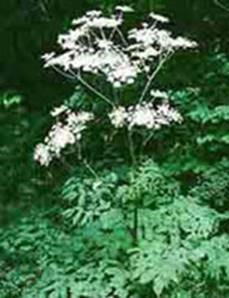
Anticancer actions of Angelica sinensis (Dong Quai) by Joseph J Collins, RN, ND
Angelica sinensis has a number of active constituents that has been widely researched for their anticancer actions. For example, polysaccharides from Angelica sinensis have can inhibit proliferation of leukemia cells [1], [2], [3], [4], as well as colorectal carcinoma cells [5]. In fact, a number of papers discuss generalized anticancer actions against multiple types of cancer cells to promote apoptosis (cell death) of tumor cells or have antiangiogenic effects [6], [7], [8], [9], [10], [11], [12], [13], [14].
The ligustilide (LGT) and the n-butylidenephthalide (BLP) in Angelica sinensis both have anticancer actions, while ferulic acid in Angelica sinensis primarily has anti-inflammatory and immunostimulatory actions [15].
Research done in 2004 did show that ferulic acid inhibited breast cancer cell growth [16.1]. A 2006 study that showed that when cultured cancer cells were exposed to both estradiol and ferulic acid the cancer cells would continue to divide, but the concentration of estradiol used in the study was 2723.8 pMol/L, which is about four time the normal range in follicular phase and twice as high as a woman would have even when she ovulates [16.2]. In 2012, research discussed the roles that angeliferulate and HMID from Angelica sinensis have in inhibiting proteins associated with cancer growth in various tissues including breasts [17].
Next Herb: Schizandra chinensis
or
Go back to the Anticancer Actions of Specific Herbs for Low Estrogen Herbs
References
To review the PubMed listing of any reference, go to www.ncbi.nlm.nih.gov/PubMed/ and enter the PubMed PMID number at the end of the reference.
[1] Jia DY, Liu J, Li CP, Li J, Zhang MS, Zhang YY, Jing Peng-Wei, Xu CY, Wang YP.[Biological mechanisms of human-derived leukemia stem cells senescence regulated by Angelica sinensis polysaccharide]. Zhongguo Zhong Yao Za Zhi. 2015Jan;40(1):112-7. Chinese. PubMed PMID: 25993799.
[2] Wang L, Jiang R, Song SD, Hua ZS, Wang JW, Wang YP. Angelica sinensis polysaccharide induces erythroid differentiation of human chronic myelogenous leukemia k562 cells. Asian Pac J Cancer Prev. 2015;16(9):3715-21. PubMed PMID: 25987027.
[3] Liu J, Xu CY, Cai SZ, Zhou Y, Li J, Jiang R, Wang YP. Senescence effects of Angelica sinensis polysaccharides on human acute myelogenous leukemia stem and progenitor cells. Asian Pac J Cancer Prev. 2014 Jan;14(11):6549-56. PubMed PMID: 24377566.
[4] Zheng M, Wang YP. [Experimental study on effect of Angelica polysaccharide in inhibitory proliferation and inducing differentiation of K562 cells]. Zhongguo Zhong Xi Yi Jie He Za Zhi. 2002 Jan;22(1):54-7. Chinese. PubMed PMID: 12585175.
[5] An J, Li XN, Zhao BC, Wang Q, Lan Y, Wu Q. [Chemo-preventive effect of Angelica sinensis' supercritical extracts on AOM/DSS-induced mouse colorectal carcinoma associated with inflammation]. Zhongguo Zhong Yao Za Zhi. 2014 Apr;39(7):1265-9. Chinese. PubMed PMID: 25011266.
[6] Chen XP, Li W, Xiao XF, Zhang LL, Liu CX. Phytochemical and pharmacological studies on Radix Angelica sinensis. Chin J Nat Med. 2013 Nov;11(6):577-87. doi: 10.1016/S1875-5364(13)60067-9. Review. PubMed PMID: 24345498.
[7] Saw CL, Wu Q, Su ZY, Wang H, Yang Y, Xu X, Huang Y, Khor TO, Kong AN. Effects of natural phytochemicals in Angelica sinensis (Danggui) on Nrf2-mediated gene expression of phase II drug metabolizing enzymes and anti-inflammation. Biopharm Drug Dispos. 2013 Sep;34(6):303-11. doi: 10.1002/bdd.1846. Epub 2013 May 23. PubMed PMID: 23640758.
[8] Chao WW, Lin BF. Bioactivities of major constituents isolated from Angelica sinensis (Danggui). Chin Med. 2011 Aug 19;6:29. doi: 10.1186/1749-8546-6-29.PubMed PMID: 21851645
[9] Cao W, Li XQ, Wang X, Fan HT, Zhang XN, Hou Y, Liu SB, Mei QB. A novel polysaccharide, isolated from Angelica sinensis (Oliv.) Diels induces the apoptosis of cervical cancer HeLa cells through an intrinsic apoptotic pathway. Phytomedicine. 2010 Jul;17(8-9):598-605. doi: 0.1016/j.phymed.2009.12.014. Epub 2010 Jan 25. PubMed PMID: 20092988.
[10] Cao W, Li XQ, Wang X, Li T, Chen X, Liu SB, Mei QB. Characterizations and anti-tumor activities of three acidic polysaccharides from Angelica sinensis (Oliv.) Diels. Int J Biol Macromol. 2010 Jan 1;46(1):115-22. doi:10.1016/j.ijbiomac.2009.11.005. Epub 2009 Nov 24. PubMed PMID: 19941888.
[11] Cao W, Li XQ, Hou Y, Fan HT, Zhang XN, Mei QB. [Structural analysis and anti-tumor activity in vivo of polysaccharide APS-2a from Angelica sinensis]. Zhong Yao Cai. 2008 Feb;31(2):261-6. Chinese. PubMed PMID: 18619275.
[12] Armstrong TS, Gilbert MR. Use of complementary and alternative medical therapy by patients with primary brain tumors. Curr Neurol Neurosci Rep. 2008 May;8(3):264-8. Review. PubMed PMID: 18541122.
[13] Chen QC, Lee J, Jin W, Youn U, Kim H, Lee IS, Zhang X, Song K, Seong Y, Bae K. Cytotoxic constituents from angelicae sinensis radix. Arch Pharm Res. 2007 May;30(5):565-9. PubMed PMID: 17615675.
[14] Cheng YL, Chang WL, Lee SC, Liu YG, Chen CJ, Lin SZ, Tsai NM, Yu DS, Yen CY, Harn HJ. Acetone extract of Angelica sinensis inhibits proliferation of humancancer cells via inducing cell cycle arrest and apoptosis. Life Sci. 2004 Aug 13;75(13):1579-94. PubMed PMID: 15261763.
[15] Chao WW, Lin BF. Bioactivities of major constituents isolated from Angelica
sinensis (Danggui). Chin Med. 2011 Aug 19;6:29. doi: 10.1186/1749-8546-6-29.
PubMed PMID: 21851645.
[16.1] Kampa M, Alexaki VI, Notas G, Nifli AP, Nistikaki A, Hatzoglou A, Bakogeorgou E, Kouimtzoglou E, Blekas G, Boskou D, Gravanis A, Castanas E. Antiproliferative and apoptotic effects of selective phenolic acids on T47D human breast cancer cells: potential mechanisms of action. Breast Cancer Res. 2004;6(2):R63-74. Epub 2003 Dec 15. PubMed PMID: 14979919.
16.2] Chang CJ, Chiu JH, Tseng LM, Chang CH, Chien TM, Wu CW, Lui WY. Modulation of HER2 expression by ferulic acid on human breast cancer MCF7 cells. Eur J Clin Invest. 2006 Aug;36(8):588-96. PubMed PMID: 16893382.
[17] Tou WI, Chen CY. Traditional Chinese medicine as dual guardians against hypertension and cancer? J Biomol Struct Dyn. 2012;30(3):299-317. doi:10.1080/07391102.2012.680030. Epub 2012 Jun 12. PubMed PMID: 22694277.
[18] Lai JN, Wu CT, Wang JD. Prescription pattern of chinese herbal products for breast cancer in taiwan: a population-based study. Evid Based Complement Alternat Med. 2012;2012:891893. doi: 10.1155/2012/891893. Epub 2012 May 28. PubMed PMID:22685488.
[19] Kan WL, Cho CH, Rudd JA, Lin G. Study of the anti-proliferative effects and synergy of phthalides from Angelica sinensis on colon cancer cells. J Ethnopharmacol. 2008 Oct 30;120(1):36-43. doi: 10.1016/j.jep.2008.07.027. Epub 2008 Jul 30. PubMed PMID: 18718517.
[20] Su ZY, Khor TO, Shu L, Lee JH, Saw CL, Wu TY, Huang Y, Suh N, Yang CS, Conney AH, Wu Q, Kong AN. Epigenetic reactivation of Nrf2 in murine prostate cancer TRAMP C1 cells by natural phytochemicals Z-ligustilide and Radix angelica inensis via promoter CpG demethylation. Chem Res Toxicol. 2013 Mar 18;26(3):477-85. doi: 10.1021/tx300524p. Epub 2013 Mar 8. PubMed PMID: 23441843
[21] Shang P, Qian AR, Yang TH, Jia M, Mei QB, Cho CH, Zhao WM, Chen ZN.Experimental study of anti-tumor effects of polysaccharides from Angelica sinensis. World J Gastroenterol. 2003 Sep;9(9):1963-7. PubMed PMID: 12970885.
[22] Chen YL, Jian MH, Lin CC, Kang JC, Chen SP, Lin PC, Hung PJ, Chen JR, Chang WL, Lin SZ, Harn HJ. The induction of orphan nuclear receptor Nur77 expression by n-butylenephthalide as pharmaceuticals on hepatocellular carcinoma cell therapy. Mol Pharmacol. 2008 Oct;74(4):1046-58. doi: 10.1124/mol.107.044800. Epub 2008 Jun24. PubMed PMID: 18577687.
[23] Gu Q, Xu JY, Cheng LG, Xia WJ. [The effect of Angelica sinensis on adhesion, invasion, migration and metastasis of melanoma cells]. Zhong Yao Cai. 2007 Mar;30(3):302-5. Chinese. PubMed PMID: 17634038.
[24] Gao M, Zhang JH, Zhou FX, Xie CH, Han G, Fang SQ, Zhou YF. Angelica sinensis suppresses human lung adenocarcinoma A549 cell metastasis by regulating MMPs/TIMPs and TGF-β1. Oncol Rep. 2012 Feb;27(2):585-93. doi: 10.3892/or.2011.1527. Epub 2011 Nov 4. PubMed PMID: 22076386.
[25] Tsai NM, Chen YL, Lee CC, Lin PC, Cheng YL, Chang WL, Lin SZ, Harn HJ. The natural compound n-butylidenephthalide derived from Angelica sinensis inhibits malignant brain tumor growth in vitro and in vivo. J Neurochem. 2006 Nov;99(4):1251-62. Epub 2006 Sep 20. PubMed PMID: 16987298.
[26] Tsai NM, Lin SZ, Lee CC, Chen SP, Su HC, Chang WL, Harn HJ. The antitumor effects of Angelica sinensis on malignant brain tumors in vitro and in vivo. Clin Cancer Res. 2005 May 1;11(9):3475-84. PubMed PMID: 15867250.
[27] Lin YL, Lai WL, Harn HJ, Hung PH, Hsieh MC, Chang KF, Huang XF, Liao KW, Lee MS, Tsai NM. The Methanol Extract of Angelica sinensis Induces Cell Apoptosis and Suppresses Tumor Growth in Human Malignant Brain Tumors. Evid Based Complement Alternat Med. 2013;2013:394636. doi: 10.1155/2013/394636. Epub 2013 Nov 10 PubMed PMID: 24319475. [28] Harn HJ, Lin SZ, Lin PC, Liu CY, Liu PY, Chang LF, Yen SY, Hsieh DK, Liu FC, Tai DF, Chiou TW. Local interstitial delivery of z-butylidenephthalide by polymer wafers against malignant human gliomas. Neuro Oncol. 2011 Jun;13(6):635-48. doi: 10.1093/neuonc/nor021. Epub 2011 May 12. PubMed PMID: 21565841.
[29] Lee WH, Jin JS, Tsai WC, Chen YT, Chang WL, Yao CW, Sheu LF, Chen A. Biological inhibitory effects of the Chinese herb danggui on brain astrocytoma.Pathobiology. 2006;73(3):141-8. PubMed PMID: 17085958.
[30] Hui MK, Wu WK, Shin VY, So WH, Cho CH. Polysaccharides from the root of Angelica sinensis protect bone marrow and gastrointestinal tissues against the cytotoxicity of cyclophosphamide in mice. Int J Med Sci. 2006;3(1):1-6. Epub 2006 Jan 1. PubMed PMID: 16421623.
[31] Xin YF, Zhou GL, Shen M, Chen YX, Liu SP, Chen GC, Chen H, You ZQ, Xuan YX. Angelica sinensis: a novel adjunct to prevent doxorubicin-induced chronic cardiotoxicity. Basic Clin Pharmacol Toxicol. 2007 Dec;101(6):421-6. Epub 2007 Oct 25. PubMed PMID: 17971065.
[32] Xie CH, Zhang MS, Zhou YF, Han G, Cao Z, Zhou FX, Zhang G, Luo ZG, Wu JP, Liu H, Chen J, Zhang WJ. Chinese medicine Angelica sinensis suppresses radiation-induced expression of TNF-alpha and TGF-beta1 in mice. Oncol Rep. 2006 Jun;15(6):1429-36. PubMed PMID: 16685376.
[33] Zhong YH, Han G, Zhou YF, Peng M, Xie CH, Zhou FX, Zhang WJ. [Protection of Angelica sinensis against radiation-induced pulmonary fibrosis in mice]. Zhonghua Yu Fang Yi Xue Za Zhi. 2007 Mar;41(2):105-9. Chinese. PubMed PMID: 17605235.
[34] Han G, Zhou YF, Zhang MS, Cao Z, Xie CH, Zhou FX, Peng M, Zhang WJ. Angelica
sinensis down-regulates hydroxyproline and Tgfb1 and provides protection in mice with radiation-induced pulmonary fibrosis. Radiat Res. 2006 May;165(5):546-52. PubMed PMID: 16669709.
